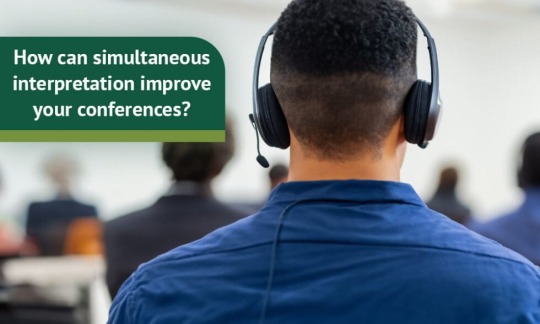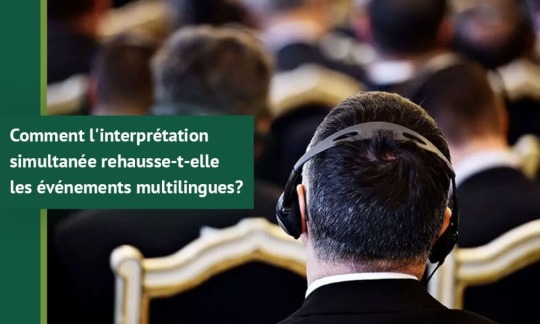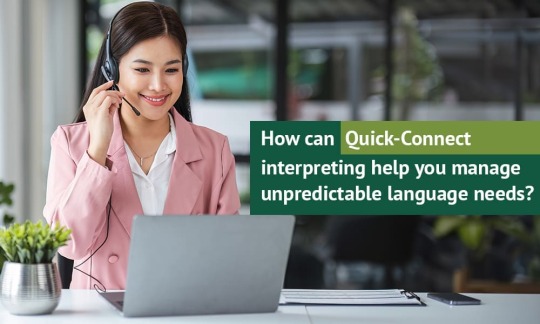Don't wanna be here? Send us removal request.
Text
In what ways can simultaneous interpretation elevate the quality of your conferences?

In our increasingly global world, language should never be a barrier at events, conferences, or business meetings. Conference interpreting is the key to breaking those barriers, ensuring smooth communication across different languages. At All Languages, we’re experts in helping businesses and organizations host successful multilingual events with high-quality conference interpreting services.
In this guide, we’ll cover the basics of conference interpreting, its different types, how to choose the right interpreters, and how modern technology is transforming this field.
Why Conference Interpreting is Crucial for Event Success
Effective communication is the backbone of every successful event, especially when participants speak multiple languages. Conference interpreting ensures that language differences don’t stand in the way of learning, collaboration, and meaningful engagement. Interpreters act as the bridge, helping ideas flow and ensuring everyone is included in the conversation.
At All Languages, we understand the importance of clarity and connection. Our expert interpreters make sure your event runs smoothly, fostering an environment where everyone can participate fully.
What is Conference Interpreting, and How Does It Work?
Conference interpreting is the process of translating spoken language in real time during live events. It involves listening to one language and instantly converting it into another so that participants can understand the conversation as it happens.
There are two main forms of conference interpreting:
Simultaneous Interpreting: The interpreter translates the message in real time as the speaker continues to talk. This type of interpreting is used for large-scale events, and it’s the most demanding because of the high cognitive load.
Consecutive Interpreting: The interpreter listens to the speaker for a few minutes, takes notes, and then delivers the translation after the speaker pauses. This method is common in smaller settings or formal discussions.
At All Languages, our interpreters excel at both methods, ensuring that communication flows smoothly, regardless of the event’s size or complexity.
The Three Main Types of Conference Interpreting
Here are the three most commonly used types of interpreting in conferences:
Simultaneous Interpreting: Real-time interpretation where the interpreter speaks while the speaker is talking. It’s used at large events, requiring interpreters with high skill levels. All Languages provides top-tier simultaneous interpreting services, ensuring clarity and flow during your event.
Whispered Interpreting (Chuchotage): This type of simultaneous interpreting is done on a smaller scale, where the interpreter whispers the translation to one or two participants. It’s ideal for small groups or individuals who need real-time interpretation without disrupting the event.
Consecutive Interpreting: The interpreter waits for the speaker to finish a segment of their speech before delivering the translation. This method allows for more detailed and accurate interpretation, often used in formal settings or press conferences.
How Are Conference Interpreters Selected?
Choosing the right interpreter for your event is crucial. At All Languages, we work with highly qualified interpreters who are native speakers of the target language and possess specific credentials. Our interpreters typically hold:
A Master of Conference Interpreting (MCI)
Certification from professional organizations like AIIC (International Association of Conference Interpreters)
Provincial certifications (ATIO, OTTIAQ, etc.)
These credentials ensure that our interpreters not only have linguistic expertise but also a deep understanding of cultural nuances and specialized knowledge in various industries.
Preparing Your Conference Interpreters for Success
Proper preparation is key to effective interpreting. Before your event, it’s essential to provide interpreters with reference materials like agendas, presentations, and glossaries. This helps interpreters familiarize themselves with the subject matter and ensures smooth, accurate communication.
At All Languages, we encourage our clients to share these materials in advance so that our interpreters can be fully prepared to meet your specific needs.
Determining the Right Number of Interpreters
The number of interpreters needed depends on the size and duration of your event. Interpreters typically work in pairs, rotating every 20-30 minutes to maintain accuracy and focus. For single sessions lasting up to four hours, two interpreters are sufficient for each language pair. However, for longer events or multiple concurrent sessions, additional interpreters will be necessary.
At All Languages, we assess your event’s requirements and ensure you have the right number of interpreters to guarantee flawless communication.
The Importance of Sound Quality in Conference Interpreting
Clear audio is crucial for successful conference interpreting. Poor sound quality can lead to miscommunication or errors in interpretation. Whether your event is in person or virtual, ensuring good audio quality allows interpreters to hear the speaker clearly and deliver accurate translations.
At All Languages, we collaborate with top AV professionals to guarantee crystal-clear sound, providing interpreters with the tools they need to perform at their best.
Enhancing Your Conference with AV Support
AV support plays a significant role in the success of conference interpreting. From providing interpreter booths and participant headsets to managing video remote platforms, AV professionals help ensure that your event’s technical needs are met.
At All Languages, we work hand-in-hand with AV teams to make sure every aspect of your event’s technical setup runs smoothly, allowing you to focus on the content and engagement of your audience.
How Technology is Changing Conference Interpreting
Advancements in technology have revolutionized conference interpreting, making it more efficient and cost-effective. Remote interpreting platforms now allow interpreters to work from anywhere, reducing travel costs and expanding access to skilled interpreters.
At All Languages, we utilize cutting-edge remote interpreting systems, providing flexibility for both in-person and virtual events. These technologies enable seamless interpretation across locations, making your event accessible to a global audience.
The Role of AI in the Future of Conference Interpreting
Artificial intelligence (AI) is starting to have an impact on conference interpreting. While AI tools can offer real-time translations and subtitles, they are not a replacement for human interpreters. Nuanced communication, cultural context, and tone require the expertise that only humans can provide.
At All Languages, we embrace AI as a complementary tool that enhances our services, but we believe human interpreters remain essential for delivering the highest quality communication.
Common Challenges in Conference Interpreting and How to Overcome Them
Conference interpreters face several challenges, such as fast-paced speech, technical jargon, and cultural differences. At All Languages, our interpreters are trained to navigate these challenges with precision and expertise. We provide them with the support and preparation they need to ensure that communication flows smoothly, even in the most complex situations.
How to Book Conference Interpreting Services with All Languages
Booking conference interpreting services with All Languages is simple. Contact us for a free quote, and we’ll provide you with a detailed breakdown of interpreter fees, equipment rental, and any additional services you might need.
We offer flexible solutions, including in-person interpreting with booths and headsets or remote interpreting through platforms like Zoom or MS Teams. Let us handle the logistics so that you can focus on hosting a successful event.
Conference interpreting is essential for ensuring that multilingual events run smoothly and that everyone is heard and understood. At All Languages, we combine human expertise, advanced technology, and cultural knowledge to provide top-tier interpreting services that make your event a success. Contact us today to learn more about how we can help you facilitate meaningful communication at your next conference.
0 notes
Text
Understanding Language Laws in Canada: Your FAQs Answered

Canada’s rich cultural tapestry is reflected in its commitment to bilingualism. With both English and French recognized as official languages, various laws guide their use across different sectors. Here’s a straightforward FAQ to help you grasp the essentials of language laws in Canada.
What are Canada’s main language laws?
Canada’s primary language laws include the Official Languages Act and the Canadian Charter of Rights and Freedoms. The Official Languages Act mandates that federal institutions provide services in both English and French. The Charter guarantees the right to communicate with federal institutions in either language.
How do these laws affect federal government services?
Federal services in Canada must be available in both English and French. This means federal documents, websites, and communications are provided in both languages. For example, if you interact with a federal agency, you can choose to receive services in English or French.
What are the language requirements in Quebec?
Quebec has its own language laws under the Charter of the French Language (Bill 101). French is the official language of the province, and most public life aspects, including business and education, must primarily use French. However, English-language services are available for eligible individuals.
What do language laws mean for businesses?
In Quebec, businesses must adhere to the Charter of the French Language, which includes using French in advertising, contracts, and customer service. In other provinces, businesses are not legally required to offer services in French but may do so to cater to a broader audience.
How are language laws applied to education?
Education in Canada is available in both English and French, reflecting the country’s bilingual nature. Federal policies and certain schools offer instruction in both languages. In Quebec, French is the primary language of instruction, though English-language schools are available for qualifying students.
Does bilingualism impact employment in Canada?
Yes, bilingualism is often a requirement for federal positions and roles that involve public interaction. Many jobs in the federal government and other sectors value employees who can speak both English and French to better serve diverse populations.
How can businesses comply with language laws?
To comply, businesses should understand the specific language requirements for their region. In Quebec, this means following the Charter of the French Language. For other regions, offering services in both English and French can improve customer experience and accessibility.
Where can I get more information about language laws?
For detailed information, consult the Official Languages Act, the Canadian Charter of Rights and Freedoms, and the Charter of the French Language. Government websites and legal resources provide comprehensive guidance on how these laws apply to various sectors.
Canada’s language laws are crucial in maintaining the country’s bilingual and multicultural identity. Whether you’re navigating federal services, operating a business, or pursuing education, understanding these laws ensures compliance and promotes inclusivity. Being informed helps you effectively engage with the bilingual nature of Canada’s public life.
0 notes
Text
In what ways does simultaneous conference interpreting benefit multilingual events?

Welcome to our comprehensive guide on simultaneous conference interpreting, a transformative force in the realm of multilingual events. In today's interconnected world, effective communication knows no language barriers. Simultaneous conference interpreting stands as a beacon, illuminating the path towards seamless interaction and understanding across diverse linguistic landscapes. In this exploration, we embark on a journey to unravel the intricacies, benefits, and best practices of simultaneous interpreting. Whether you're an event organizer, participant, or language enthusiast, prepare to immerse yourself in the world of simultaneous conference interpreting like never before.
1. What exactly is simultaneous conference interpreting? Simultaneous conference interpreting is a specialized form of interpretation where skilled linguists render spoken content into the target language in real-time, synchronously with the speaker. This dynamic mode of interpretation is the cornerstone of multilingual events, ensuring fluid communication across language barriers.
2. How does simultaneous interpreting elevate multilingual events? Simultaneous interpreting serves as the catalyst for elevating multilingual events to new heights. By seamlessly translating speeches and discussions in real-time, it fosters inclusivity, engagement, and comprehension among participants from diverse linguistic backgrounds.
3. What are the primary advantages of simultaneous interpreting?
Seamless communication: Simultaneous interpreting facilitates smooth and uninterrupted communication flow, enabling participants to engage with content without delays.
Time efficiency: By eliminating pauses for interpretation, simultaneous interpreting optimizes event schedules, maximizing productivity and audience satisfaction.
Enhanced engagement: Participants can fully immerse themselves in the event's proceedings, leading to heightened interaction, collaboration, and knowledge exchange.
Accuracy and fidelity: Skilled interpreters ensure that the essence, nuances, and subtleties of the original message are faithfully conveyed, preserving the integrity of communication across languages.
4. What are the main challenges faced in simultaneous interpreting?
Cognitive demand: Simultaneous interpreters must possess exceptional cognitive abilities to process, analyze, and convey information accurately in real-time, often under high-pressure conditions.
Technical requirements: Successful simultaneous interpreting necessitates the use of specialized equipment such as soundproof booths, microphones, and headsets to facilitate clear communication, adding logistical complexity to events.
Fatigue management: The intensive nature of simultaneous interpreting can lead to mental and physical fatigue over prolonged periods, requiring interpreters to implement effective strategies for rest and rejuvenation.
5. How can event organizers ensure the effectiveness of simultaneous interpreting?
Partner with reputable language service providers: Collaborate with established language service providers to enlist qualified interpreters with expertise in simultaneous interpreting.
Provide adequate resources: Ensure that the event venue is equipped with state-of-the-art technical infrastructure, including soundproof booths, quality microphones, and headsets to optimize interpretation quality.
Plan meticulously: Communicate language requirements and event details to interpreters well in advance, allowing sufficient time for preparation and coordination to ensure a seamless interpreting experience.
Simultaneous conference interpreting stands as a cornerstone of successful multilingual events, transcending linguistic boundaries to unite global audiences in meaningful dialogue and collaboration. By embracing the principles, benefits, and challenges of simultaneous interpreting, event organizers can harness its transformative power to create immersive, inclusive, and impactful experiences for participants worldwide. We trust that this FAQ guide has provided valuable insights into the essence of simultaneous interpreting and its pivotal role in shaping the future of multilingual communication.
0 notes
Text
What are Quick-Connect interpreting services and why are they important in today's multilingual world?

Quick-Connect interpreting services are essential tools that allow individuals to swiftly connect with professional interpreters via telephone or video remote, regardless of their location or the time. In today's diverse global landscape, where language barriers are prevalent, these services play a vital role in facilitating rapid and effective communication across linguistic divides, especially in urgent scenarios like call centers, emergencies, or situations requiring frequent, short-term interpreting needs.
How does Quick-Connect serve various industries and their language requirements?
Quick-Connect is a versatile on-demand service designed to meet the diverse language needs of various sectors, including call centers, emergency services, legal, education, healthcare, and customer service. It offers flexibility and accessibility, ensuring seamless communication even in time-sensitive or brief discussions where language barriers could otherwise hinder service delivery.
Can you outline the key aspects of Quick-Connect and how All Languages ensures the quality and reliability of its services?
Quick-Connect encompasses both Over-the-Phone Interpreting (OPI) and Video Remote Interpretation (VRI) services, available on demand. All Languages upholds stringent standards by subjecting remote interpreters to rigorous testing and regular quality assessments. Additionally, the service operates on a per-minute billing basis, aligning well with Canada's linguistic diversity.
Could you explain the process of using Quick-Connect and the support provided by All Languages?
Utilizing Quick-Connect is straightforward for clients, who can set up an account and access the service via a toll-free number or hyperlink from the My.AllLanguages.com web portal. All Languages ensures a live attendant is always available to promptly assess language needs and connect clients with suitable interpreters, offering round-the-clock support to effectively overcome language barriers.
How does Quick-Connect leverage technology to enhance its service delivery?
Quick-Connect integrates various technological platforms, including call center systems, CRM applications, web applications, VOIP, and networking technologies, to facilitate rapid call distribution, efficient client management, and secure, high-quality connections between clients and interpreters.
What qualifications and credentials do interpreters within the Quick-Connect network possess?
Interpreters within the Quick-Connect network meet stringent criteria, including a minimum of 2 years of prior experience, at least 40 hours of interpreter training, and annual HIPAA certification. All Languages prioritizes collaborating with certified and highly qualified interpreters to maintain professionalism and efficiency.
What standards of performance can clients expect from Quick-Connect interpreters?
Clients can expect simplicity, confidentiality, cooperation, cultural sensitivity, and a high level of professionalism from Quick-Connect interpreters. Equipped with the necessary expertise and tools, they ensure a seamless and efficient interpreting experience.
How can individuals obtain more information or begin using Quick-Connect services?
Those interested in Quick-Connect services can reach out to All Languages for further information and assistance in getting started.
0 notes
Text
Explore the modernization of language services through VRI's pivotal role, as explained by All Languages' experts.

Curious about the impact of digital technologies on the language services industry? The experts at All Languages offer insights into how Video Remote Interpreting (VRI) is transforming interpretation, particularly in legal, education, conference, and healthcare settings.
In today’s digital age, video content has become essential to our daily interactions, replacing traditional face-to-face meetings and becoming the preferred medium for various gatherings. As pioneers in pre-arranged interpretation services, our clients were among the few able to communicate across language barriers during the early stages of COVID-19. The subsequent global shift to video conferencing underscores the importance of integrating video into language services while partnering with an innovative and trusted provider.
VRI provides numerous benefits. What makes it a preferred option in language services? The professional team at All Languages highlights several advantages:
Pre-arranged interpretation services:
Cost-effectiveness for short sessions compared to on-site interpreting.
Lower minimum billings and no travel expenses.
On-demand/quick-connect service:
Ideal for short or emergency calls.
Pay-per-minute service model.
Common benefits:
Greater interpreter selection and availability leading to higher qualifications.
Enhanced understanding of non-verbal cues compared to over-the-phone interpretation.
Easy access to American Sign Language (ASL) and Langue des signes du Québec (LSQ) interpreters.
Improved access to qualified interpreters in remote areas.
Services accessible from any internet-enabled device.
Option for clients to record or save video sessions.
Security and user experience are paramount across all linguistic services, including VRI. All Languages provides a secure, encrypted network, an interpreter call-back function to prevent missed calls, and a professional interface compatible with various devices and platforms.
Using VRI is simple. You just need a device with internet access and a webcam. All Languages’ service is compatible with different devices and platforms, ensuring seamless access to high-resolution, HIPAA-compliant video for clear communication.
Interested in learning more about how VRI can benefit your organization? Contact All Languages for personalized guidance and to explore our comprehensive language services.
0 notes
Text
Navigating Interpreting Services: A Comprehensive Guide

Understanding the most effective way to request interpreting services in diverse and multilingual environments is essential. Whether you require interpreting for legal, medical, educational, business, or event purposes, this concise guide aims to help you navigate the process efficiently.
Our strategy revolves around four key stages: gathering requirements, conducting a needs assessment, booking and selecting resources, and providing evaluation and feedback. By following these steps, you can streamline your interaction with Interpreting Service Providers (ISPs) and improve overall customer satisfaction.
How do you start the process of gathering requirements for interpreting services?
Initiating the process involves pinpointing your specific interpreting needs. Utilizing our customer web portal and dedicated coordinators, we guide you through a comprehensive checklist covering language preferences, assignment types, interpreter gender preferences (if applicable), relevant file numbers, appointment details, contact information, and any special instructions.
What happens during the needs assessment stage of the process?
After conveying your requirements, an interpreting coordinator carefully reviews them and recommends the most suitable service. Our range of scheduled interpreting services includes Face-to-Face (F2F) consecutive, simultaneous/conference interpreting, over-the-phone (OPI), and video remote interpretation (VRI), with on-demand availability for OPI and VRI quick-connect interpreting. Each service is tailored to various settings and scenarios, spanning legal, medical, social services, education, conferences, and special events.
How important is advance notice and detailed booking information in ensuring efficient service?
Providing detailed booking information with ample advance notice is crucial for accurate and efficient service. While same-day service is possible, requesting an interpreter several days or months beforehand is recommended to secure the most suitable candidate(s). For any necessary adjustments, clients can refer to their order confirmation email or visit our customer web portal.
What criteria are taken into consideration in the selection of interpreters by ISPs?
ISPs employ a rigorous selection process, considering factors such as linguistic proficiency, educational background, professional certifications, domain-specific experience, performance track record, certification status, interpretation mode, and anticipated duration.
Why is client feedback solicited, and how is it utilized?
Client feedback is invaluable for continuous improvement. ISPs typically request feedback to maintain high standards and promptly address any concerns. Best practices include including satisfaction survey links on client order confirmation and invoice templates, as well as distributing surveys after the completion of initial orders, followed by biannual surveys when interpreters are engaged.
Conclusion:
In conclusion, adopting a proactive approach by carefully gathering and articulating your requirements, thoroughly reviewing and understanding the recommendations provided by ISPs, diligently attending to booking particulars, and providing constructive feedback is essential for a successful experience with interpreting services. This guide serves as a comprehensive resource for individuals seeking interpreting services, whether they are new to the process or experienced. For a more tailored approach, please feel free to contact us.
1 note
·
View note